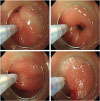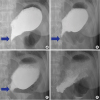INTRODUCTION
MATERIALS AND METHODS
Fig. 1

RESULTS
Table 1
Clinical characteristics of the post-PPG patients who underwent intrapyloric botulinum toxin injection

Table 2
Outcomes of the intrapyloric botulinum toxin injection

Fig. 2

Journal List > J Gastric Cancer > v.17(2) > 1077055




Jung Hwan Lee 
https://orcid.org/0000-0001-7567-0664
Chan Gyoo Kim 
https://orcid.org/0000-0002-1651-2559
Young-Woo Kim 
https://orcid.org/0000-0002-1559-9672
Il Ju Choi 
https://orcid.org/0000-0002-8339-9824
Jong Yeul Lee 
https://orcid.org/0000-0001-8709-5097
Young-Il Kim 
https://orcid.org/0000-0002-2614-3419
Bang Wool Eom 
https://orcid.org/0000-0002-0332-2051
Hong Man Yoon 
https://orcid.org/0000-0002-6218-7080
Keun Won Ryu 
https://orcid.org/0000-0002-5935-9777